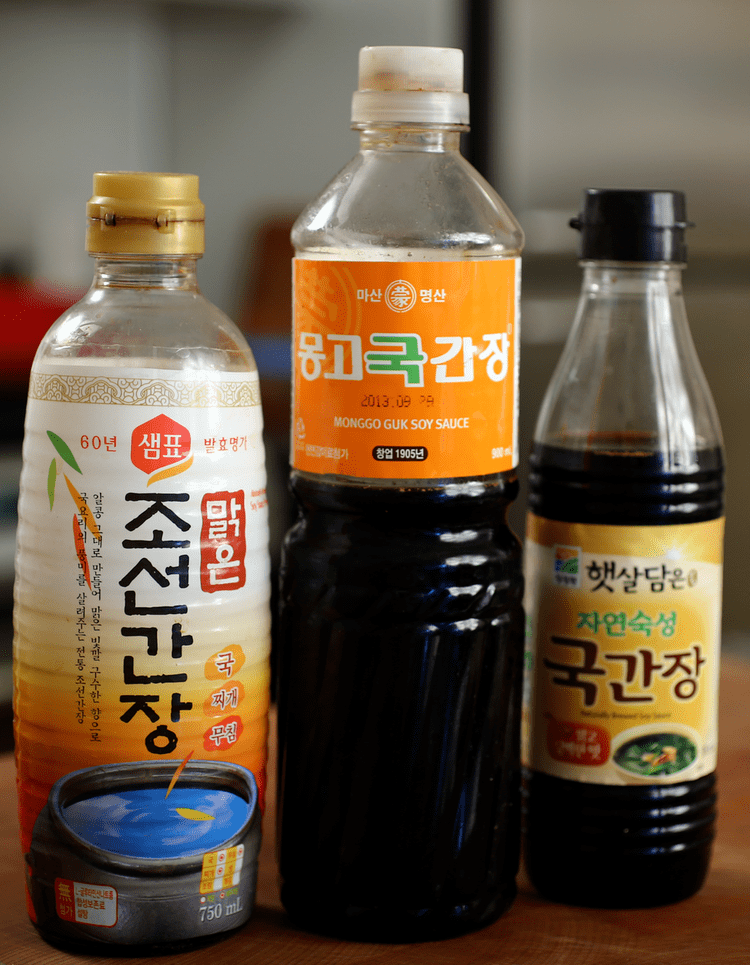 | ||
Similar Bap, Juk, Suksilgwa, Mandugwa, Gwapyeon | ||
Soup soy sauce is a type of Korean soy sauce (ganjang) made entirely of fermented soybean(meju) and brine. It is also a byproduct of doenjang production. Both lighter in colour and saltier than other Korean ganjang varieties, soup soy sauce is used mainly in guk(soup) and namul(seasoned vegetable dish) in modern Korean cuisine.
Contents
Names
Soup soy sauce is called by many different names due to its complicated status changes in relation with other types of Korean soy sauces. In English speaking world, it is most commonly known as soup soy sauce, which is a direct translation of guk-ganjang.
History
The earliest soy sauce brewing in Korea seem to have begun prior to the era of the Three Kingdoms. The Records of the Three Kingdoms, a Chinese historical text written and published in the 3rd century, mentions that "Goguryeo people are good at brewing fermented soy beans." in the section named Dongyi (Eastern foreigners), in the Book of Wei. Jangdoks used for soy sauce brewing are found in the mural paintings of Anak Tomb No.3 from the 4th century Goguryeo.
In Samguk Sagi, a historical record of the Three Kingdoms era, it is written that ganjang and doenjang along with meju and jeotgal were prepared for the wedding ceremony of the King Sinmun in February 683. Sikhwaji, a section from Goryeosa (History of Goryeo), recorded that ganjang and doenjang were included in the relief supplies in 1018, after a Khitan invasion, and in 1052, when a famine occurred. Joseon texts such as Guhwangchwaryo and Jeungbo sallim gyeongje contain the detailed procedures on how to brew good quality ganjang and doenjang. Gyuhap chongseo explains how to pick a date for brewing, what to forbear, and how to keep and preserve ganjang and doenjang.
Production
Soup soy sauce is made entirely of fermented soybean and brine. The brewing process also produces doenjang (Korean fermented bean paste).
Meju, Korean soybean brick, is made around ipdong in early November. Soybeans are soaked overnight, boiled in salt water, and then pounded in a mortar(jeolgu) or coarsely ground in a millstone. About a doe(≈1.8 litres) or two does of pounded soybean is chunked, compressed, and shaped into a cube or a sphere called meju. The meju bricks are then dried in a cool shaded area for a week to several weeks until firm. When the bricks harden, they are tied with rice straws to the eave of the house, or put in the warm ondol room with rice straws, for fermentation. In jeongwol, the first month of the Lunar year, well fermented meju bricks are washed and sun-dried.
After drying, the meju bricks are aged in onggi crocks(jangdok) with brine. Charcoal and chillies are added for their adsorbent and antibacterial properties, as well as folk-religious beliefs that they drive evil spirits away. As the fermentation progresses, brine acquires flavour and colour. This aged brine is boiled to become soy sauce(soup soy sauce), and the rest (aged meju chunks) are mashed to become soybean paste(doenjang).
Types
Korean Ministry of Food and Drug Safety's Food Code classifies hansik ganjang into two categories by their ingredients.
Depending on the length of aging, hansik ganjang can be divided into three main varieties: clear, middle, and dark.
